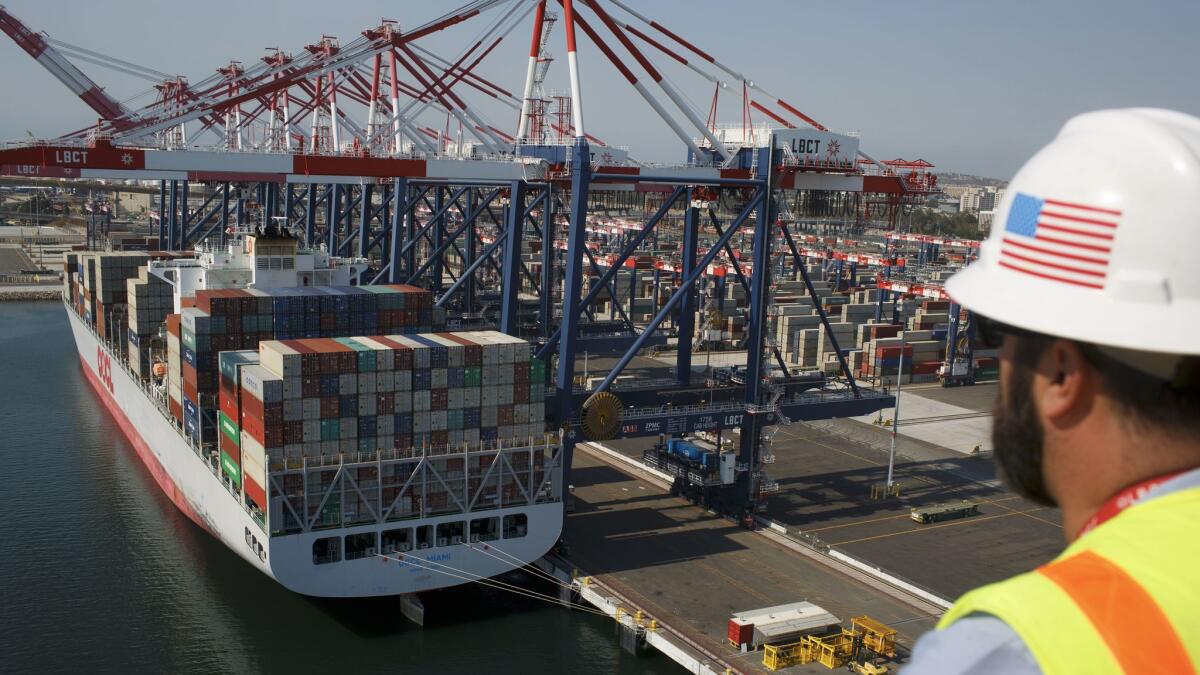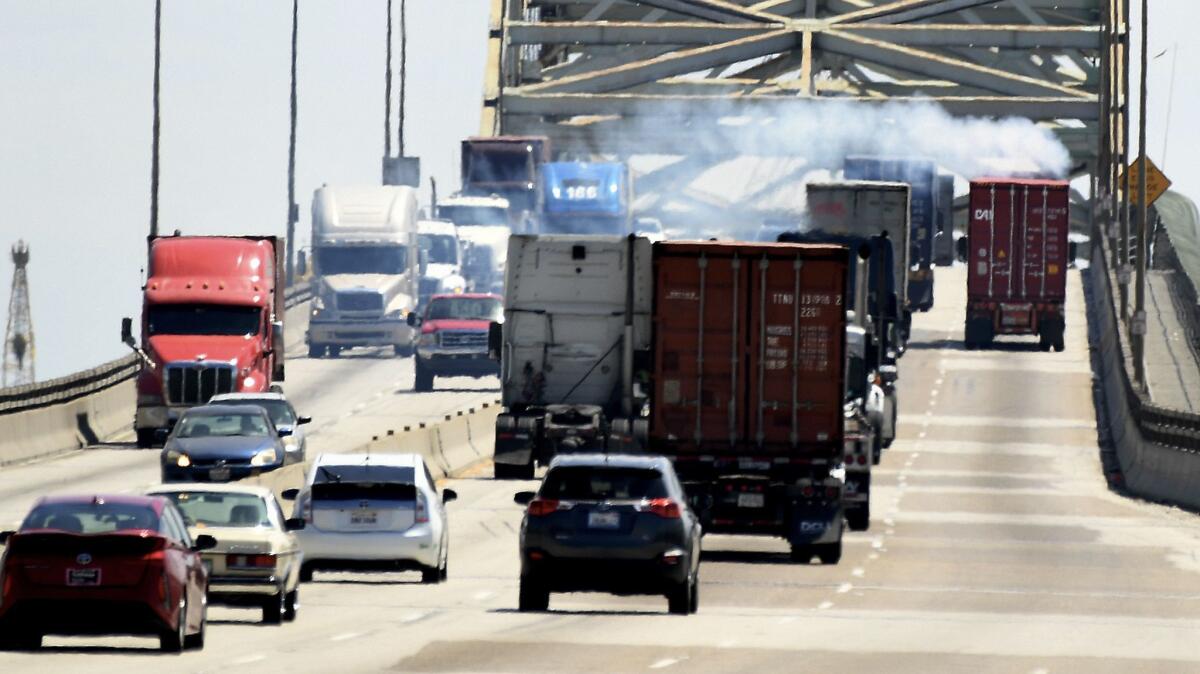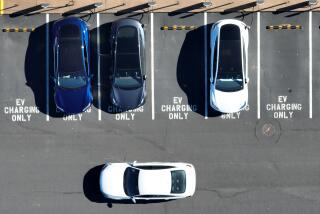Plan calls for L.A., Long Beach ports to go to zero-emissions technology; cost could hit $14 billion

The nation’s largest port complex will seek to slash air pollution and health risks to Southern Californians by replacing diesel trucks and cargo equipment with zero-emissions technology over the next two decades, according to a plan released Wednesday.
The Long Beach and Los Angeles ports’ Clean Air Action Plan aims to further reduce health-damaging and planet-warming emissions at the sprawling hub for thousands of freight-moving trucks, trains and ships — at a projected cost of up to $14 billion in public and private funds.
The blueprint comes more than a decade after the ports pioneered a major greening of their operations by phasing out the dirtiest sources of diesel pollution. But it marks the beginning of a larger, more significant transformation: the shift away from the internal combustion engine entirely.
Despite steep reductions in diesel emissions over the last decade, progress has tapered off recently, and the ports remain Southern California’s largest single source of air pollution. Their operations are fueled by international trade that has nearly tripled the volume of shipping containers moving through the complex since the mid-1990s.
Emissions from moving all those products and goods worsen smog as far away as the Inland Empire — and afflict residents in harbor-area communities with higher asthma rates and cancer risk in what has been labeled the “diesel death zone.”
The plan sets goals of switching to zero-emission cargo-handling equipment by 2030 and trucks by 2035. It also sets targets to slash port-related greenhouse gas emissions to 40% below 1990 levels by 2030, and to 80% by 2050.
“These ports are going where no port has gone before,” said Port of Los Angeles Executive Director Gene Seroka. “Based on what we’ve already accomplished to promote healthy, robust trade through our gateway, we’re ready to make history again, looking at a new array of technologies and strategies to further lower port-related emissions in the decades ahead.”
One of the biggest questions raised Wednesday by industry and environmentalists was how the thousands of new trucks and pieces of equipment would be paid for — not to mention how quickly the change-over realistically could happen.
Port officials predict that the cost of going to zero emissions will dwarf the estimated $2 million it took to implement the 2006 clean-air plan. Finding subsidies will put the ports in competition with an array of projects for a limited pot of pollution-reduction money, including California’s controversial bullet train.
But much of the plan’s significance, experts said, lies in the message it sends to manufacturers and suppliers: There will be a market to justify their investments in vehicles and equipment with no tailpipe emissions.
“This may be the most important signal we’ve seen about a transition to zero emission for the freight sector,” said Daniel Sperling, director of the Institute of Transportation Studies at UC Davis and a member of the state Air Resources Board. “When a place like L.A. says this is our plan, this is our goal, it sends a signal to a lot of other ports, to policymakers elsewhere.”
While environmentalists welcomed many elements of the plan, they criticized its lack of new targets for reducing smog-forming emissions as well as measures to ensure speedy progress and ease pollution-triggered health problems.
“The plan relies too heavily on yet-to-be-developed state regulations, millions in yet-to-be-located subsidies and voluntary programs,” said Melissa Lin Perrella, an attorney with the Natural Resources Defense Council. “At the end of the day, we have to ask if the words on paper will make the air safe to breathe. The plan is not there yet.”
And industry groups and truckers expressed big concerns about the price tag.
A fleet of short-haul, heavy-duty trucks capable of servicing the ports’ needs with zero tailpipe emissions does not exist. To address that, officials are planning demonstration projects to create demand for new technologies in order to bring the cost down.
Weston LaBar, executive director of the Harbor Trucking Assn., said it was important “that we don’t saddle an industry that has invested billions of dollars in clean technology with a mandate that is not viable commercially or operationally.”
Diesel powers 96% of trucks serving the complex, with only three electric or hybrid vehicles among the more than 17,000 active big rigs at the facilities, port records show. Less than 9% of the ports’ terminal equipment is zero-emissions.
To make the transformation, the ports will rely on a suite of measures to encourage the elimination of diesel-fueled cranes, yard tractors and other cargo-handling equipment as well as the replacement of diesel big rigs with near-zero-emissions technologies such as natural gas. The plan then would use incentives to switch trucks to battery-electric, fuel cell or other technologies still under development.
The plan also contemplates measures to reduce pollution from ships as they approach and dock at the ports.
Key to the proposal is a clean trucks program that, starting in 2018, would require new big rigs entering the ports’ registry to have engines of model year 2014 or newer. In 2023, new trucks joining the registry would have to meet a stricter, near-zero-emissions standard; those that don’t would be charged a fee to enter port terminals.
By 2035, only zero-emission vehicles would be exempted from those charges.
The ports project the plan will cost an additional $8 billion to $14 billion compared with what it would cost to continue operating with traditionally fueled equipment and vehicles.
Business groups said the plan will place too heavy a burden on Southern California’s economy and put its freight-moving industries at a disadvantage at a time of increasing competition with other seaports.
The L.A.-Long Beach ports handle roughly 40% of U.S. imports, and trade through the complex supports hundreds of thousands of jobs throughout the region.
“If we miss the opportunity to balance ongoing environmental progress with policies that increase throughput and ensure competitiveness, the region’s economy, businesses and residents will suffer,” said John McLaurin, president of the Pacific Merchant Shipping Assn.
McLaurin criticized the ports’ projections for the cost of switching to zero-emission terminal equipment as “pie-in-the-sky budgeting” and predicted dramatically higher costs that “will not occur with a corresponding increase in shipping container volume or efficiency.”
But environmentalists said the ports should look to industry to shoulder its fair share of the cost of cleaning the pollution it has released for many years.
Sylvia Betancourt, program manager for the Long Beach Alliance for Children with Asthma, said that “the cost of looking into your child’s eyes searching for you to help them breathe cannot be measured in dollars.
“Families pay with increased anxiety, healthcare costs and missed school and work days,” she said.

Los Angeles Mayor Eric Garcetti and Long Beach Mayor Robert Garcia — who both signed a declaration last month pledging to move to zero emissions at the ports — on Wednesday said the proposal was an important step toward their goal.
“Our port can be the global model for clean air, healthy communities and effective operations,” Garcetti said.
Some of the pollution-reducing strategies rely on actions pledged this year by state air quality officials, who plan to draft regulations targeting emissions from ships and cargo-handling equipment.
The plan is the second update since the 2006 initiative — which banned older, dirtier trucks and included programs to reduce emissions from cargo ships — launched dramatic reductions in diesel emissions and fine particulate matter.
The new proposal is being billed as “the largest environmental investment ever undertaken by a port complex” — one that cannot be successful without huge investments from the state and federal governments.
It calls for stricter federal emissions standards for trucks, trains and other leading freight pollution sources, an idea seemingly at odds with the Trump administration’s moves to roll back air quality regulations and other environmental protections.
Another obstacle, according to the ports, is a provision in Senate Bill 1 — the gas tax and vehicle fee hikes signed into law in April by Gov. Jerry Brown — that bars the state from adopting requirements to replace or retrofit heavy-duty trucks before they have reached 800,000 vehicle miles or 18 years on the road.
The ports say that for trucks, at least, that will prevent them from using a successful model they relied on a decade ago, in which they required early compliance with looming state regulations.
A spokeswoman for the Air Resources Board said “nothing in SB 1 precludes ports from taking action to protect their communities from toxic pollution.”
UPDATES:
4:35 p.m.: This article was updated with details on the plan and comments from industry and environmental activists.
This article was originally published at 11:55 a.m.
More to Read
Sign up for Essential California
The most important California stories and recommendations in your inbox every morning.
You may occasionally receive promotional content from the Los Angeles Times.











